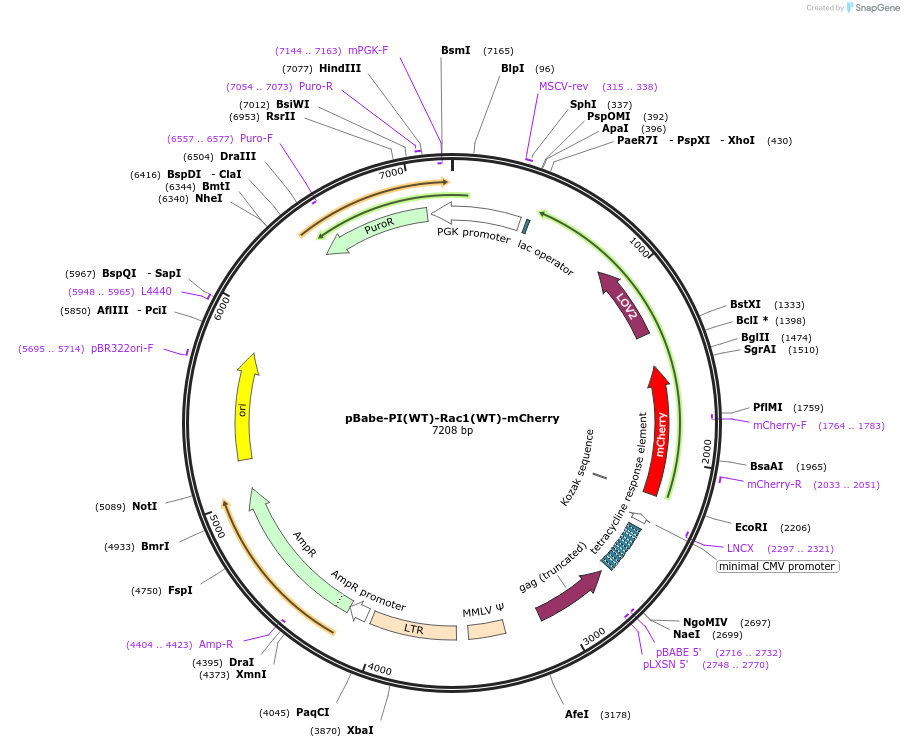pBabe-PI(WT)-Rac1(WT)-mCherry
(Plasmid
#87550)
-
PurposePI(WT): Photo-inhibitable/blue light sensitive Rac1
-
Depositing Lab
-
Publication
-
Sequence Information
Ordering
| Item | Catalog # | Description | Quantity | Price (USD) | |
|---|---|---|---|---|---|
| Plasmid | 87550 | Standard format: Plasmid sent in bacteria as agar stab | 1 | $89 | |
Backbone
-
Vector backbonepBABE
- Backbone size w/o insert (bp) 5371
- Total vector size (bp) 8131
-
Vector typeMammalian Expression, Bacterial Expression
-
Selectable markersPuromycin
Growth in Bacteria
-
Bacterial Resistance(s)Ampicillin, 100 μg/mL
-
Growth Temperature37°C
-
Growth Strain(s)DH5alpha
-
Copy numberHigh Copy
Gene/Insert 1
-
Gene/Insert nameLOV2
-
SpeciesSynthetic
-
Insert Size (bp)447
- Promoter CMV
-
Tag
/ Fusion Protein
- mCherry (N terminal on backbone)
Cloning Information for Gene/Insert 1
- Cloning method Unknown
- 5′ sequencing primer GAGATCAAGCAGAGGCTGAAG
- 3′ sequencing primer AAGTTCTTTTGCCGCCTCATC
- (Common Sequencing Primers)
Gene/Insert 2
-
Gene/Insert nameRac1
-
Alt nameras-related C3 botulinum toxin substrate 1 (rho family, small GTP binding protein Rac1)
-
SpeciesH. sapiens (human)
-
Insert Size (bp)2031
-
GenBank ID5879 5879
-
Entrez GeneRAC1 (a.k.a. MIG5, MRD48, Rac-1, TC-25, p21-Rac1)
- Promoter CMV
Cloning Information for Gene/Insert 2
- Cloning method Unknown
- 5′ sequencing primer GAGATCAAGCAGAGGCTGAAG
- 3′ sequencing primer AAGTTCTTTTGCCGCCTCATC
- (Common Sequencing Primers)
Terms and Licenses
-
Academic/Nonprofit Terms
-
Industry Terms
- Not Available to Industry
Trademarks:
- Zeocin® is an InvivoGen trademark.
These plasmids were created by your colleagues. Please acknowledge the Principal Investigator, cite the article in which the plasmids were described, and include Addgene in the Materials and Methods of your future publications.
-
For your Materials & Methods section:
pBabe-PI(WT)-Rac1(WT)-mCherry was a gift from Klaus Hahn (Addgene plasmid # 87550 ; http://n2t.net/addgene:87550 ; RRID:Addgene_87550) -
For your References section:
Engineering extrinsic disorder to control protein activity in living cells. Dagliyan O, Tarnawski M, Chu PH, Shirvanyants D, Schlichting I, Dokholyan NV, Hahn KM. Science. 2016 Dec 16;354(6318):1441-1444. 10.1126/science.aah3404 PubMed 27980211



